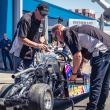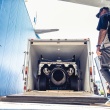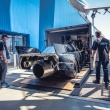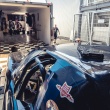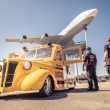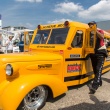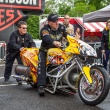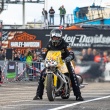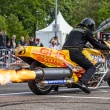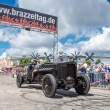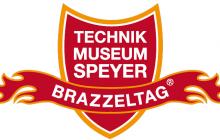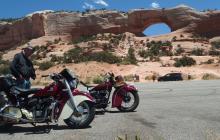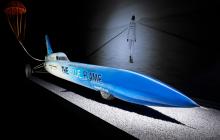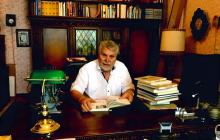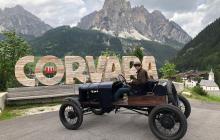Gerd Habermann has been a fan of dragster sports since his early teenage years. At the age of 18, he started racing himself. Today, he leads Europe’s largest and most successful drag racing team and is a multiple German Dragrace Champion and European record holder.
Gerd is probably known to most of our fans. Due to the presentations of his rocket school bus and his dragster bike at our annual BRAZZELTAG, he has become an institution at the Technik Museum Speyer. In May, he visited our Technik Museum with Junior Dragster racer Chantal Wagner and provided us with his “Batmobile” dragster for our exhibition.
We seized this opportunity and asked Gerd a few questions about his career and his upcoming world record attempt.
.jpg)
How did you get into dragster sports?
It all began in Langendiebach near Hanau, Germany. That is where drag racing started in Germany in the 1960s. In summer, the GIs (note: term for American soldiers) used to carry out their private races at the US airfield on Sundays. When I was a 15-year-old teenager, I used to drive there with my friends on our mopeds. Not necessarily because of the races but because you were allowed to enter the barracks and they had hamburgers and coke there. Back then, you couldn’t get that in Germany.
At the airfield, I saw my very first drag race and I was fascinated. Since then, we went there multiple times a year and watched the races. At 18, I participated for the first time in my road car. At the time, I had a tuned Opel Manta A. In order to participate, you had to pay an entry fee of 20 dollars and have a starting licence, which I had obtained shortly before. Back then, the prize money depended on the crowd. You could win up to 2,500 dollars per race. Of course, my first race wasn’t successful but it was fun and it made me curious.
.jpg)
How did you continue from there?
In the following years everything developed quite a lot. The races were usually international, with lots of Swedes and Englishmen. From time to time, I won some of the races. One year, someone wanted to sell a dragster at a race: a competition-dragster with a four-cylinder Volvo engine. That was my very first own dragster. I bought it, remodelled it, and drove it successfully for two years.
After that I wanted more and built my first small-block engine with a compressor. With the new engine I was able to compete with the US-Americans who had always been superior with their eight-cylinder engines before. Then, I hit the ground running. In 1987 and 1988, I was almost invincible in the Euro Series. In 1990, I decided to travel to Pomona, USA, and participate in the Winternationals for the first time. There, I bought my first American dragster. It was a rolling chassis, i.e. a chassis without bodywork but with a powertrain that enables it to move under its own power. I assembled the rest myself.
With that new dragster, I became even more successful and finally found some renowned sponsors. Thereby, I was able to afford good-quality, sustainable, and fast materials and become even more successful. Soon, I bought my next dragster. I usually built most of my dragsters myself, except for the chassis. The chassis should always be made by experts. After all, the car is supposed to be fast and drive straight ahead. In Germany, several people tried that but all of them failed. I always buy rolling chassis in the US or have them made specifically for me. Then, I build the electrical system and the gear unit myself. I now have 15 cars and three motorcycles. That makes me the owner of Germany’s largest racing stable.
What does your daily routine look like?
15 years ago, I turned my hobby into a career and gave up my garage. When I was on the road, the garage always fell by the wayside. So, I had to choose. Now, I invest 365 days of the year in drag racing and earn my money with it. That’s not always easy. In Europe, I am the only professional, i.e. the only one who doesn’t do anything else besides drag racing. In the US, it’s different – they have many professional drag racers. Fortunately, due to my success, I have sponsors. That’s how I am able to make a living.
I’m not sure how this year is going to go. Everything is cancelled until August. We don’t know if the NitrOlympx will take place yet. I hope it will. Since it is Europe’s largest race, it is the biggest highlight of the year. And I am basically at home on the Hockenheimring. If it doesn’t take place, it would be a pity for everyone.
.jpg)
Our BRAZZELTAG is affected by this as well – an event you have already enriched three times with your show rides. You usually showcase your school bus here. How did you end up with this turbine-driven show car?
I have been doing this for over 40 years. I try to always present something new and spectacular to the audience and the organisers. Suddenly, it seemed obvious to me: drag races originally come from the US, so remodelling an American school bus seemed perfect. It was ideal because I have several turbine-driven vehicles.
The BRAZZELTAG isn’t a race – in general, the BRAZZELTAG can’t be compared to any other event – what does this event mean to you?
The BRAZZELTAG is VERY special to me. It’s true, it’s not a race – but the feeling on the premises is incredible. Fascinating the crowd with my bus or, since recently, my jet bike, is a great pleasure to me. Every meeting and every race have their own special audience. The BRAZZELTAG, however, always has a very mixed audience. It has everything: smoke, smell, burnt tyres, vintage cars, parties – following the NitrOlympx, the BRAZZELTAG is my second biggest highlight and I’m happy to come back every year.
.jpg)
Today, you came to our museum with Chantal Wagner, the promising Junior Dragster racer. You have taken care of young racers for years. How come?
I am a father of three children who are adults now. All of them drove dragsters, just like me. In 1993, I bought my first Junior Dragster, the first one in Europe. I remember it as if it were yesterday. Back then, there was an article in the NHRA magazine (note: National Hot Rod Association) about how English-Town-Race-Cars, a dragster manufacturer from the US, invented and built a Junior Dragster. I immediately called them and told them that I needed one for my daughter. They said it would take three months to deliver. I told them that I was from Germany and that I could promote their product in Europe. A few days later, they called me back to let me know that I could have one after all – one that another client couldn’t pay for at the moment. They prepared it for shipping right away and sent it to me.
I was the first person in Europe to own a Junior Dragster. In the end, all of my children drove Junior Dragsters. That’s how I started supporting young talents.
For juniors, this sport isn’t always easy. In Hockenheim, for example, there are usually 50 racers starting. Only 16 of them qualify for the next race. The rest has to go home. It is always very disappointing, especially for children.
.jpg)
But Chantal has petrol running through her veins – her previous quad career is only one reason why. She has it all. I got to know her and her family at the Hockenheimring as I wanted to sell a Junior Dragster. She was very interested in drag racing in general. During our conversation, I found out that Chantal is a successful quad racer. We then went to a dragster race of the DMSB (Deutscher Motor Sport Bund, lit. German Motor Sports Association) in Zerbst, Germany, together. Since Chantal had a DMSB licence from her quad career and already had racing experience, she was allowed to test the dragster on the race track after the race. She tasted blood right away.
So, in the evening, I taught her how to drive a dragster. Fortunately, I already had experience in teaching beginners. She had fun immediately and was really good at it.
That is how everything started with Chantal and now, after only a short time, she already races very successfully for my team.
.jpg)
You want to set a new world record. 700 kph in 3 seconds. How did you come up with this idea?
I won the German Championship 30 times. Last year, I won seven titles. I am a double champion in both classes in which I compete, Super Competition and SuperProET. I’m also the overall Champion in Germany. I have experienced everything I ever dreamt of. I want another challenge, I need a new kick. My best time is 5.9 seconds at 480 kph. There is no big difference to my record attempt. However, in those dimensions, it’s still a kick even for me.
The current record, set in 1978 by Sammy Miller, is at 600 kph in 3 seconds. I was fascinated by that record back then and I’ve wanted to experience that ever since. But there’s only one Sammy Miller and sadly he died a few years ago. I found out who provided him with his equipment and who built his cars. I contacted that person, visited him in the US, got all the necessary parts and had a new chassis built for me.
Now, it’s my turn to build the rest. The bodywork is finished but the drive is going to take some more time. It’s all very specific. I have to reconstruct everything and stick to the tips and parts of my contact person. One of my friends is helping me with that. He has already built a jetpack by himself and knows a great deal about that.
I will soon start the testing phase. There are race tracks that you can rent cheap in order to do test runs. First, you have to roll with a little fuel and be cautious. I would love to do the record attempt at the Hockenheimring. Hockenheim has a solution for the biggest problem: the braking distance. Technically, nothing else should get in the way of my world record. My car is 200 kg lighter than Sammy’s was at the time and my engine is a lot bigger. I hope it works out next year.
The stories and reports represent the opinions and perspectives of the respective authors. Please note, especially while reading articles about our events, that binding information (e.g. opening hours, admission fees and programme) is only published on the museum's official website www.technik-museum.de.
Please note that the pictures, texts and videos published here are subject to the copyright of the respective authors and / or the museum and may not be used without permission.
Keep up-to-date with new articles
We recommend to subscribe to the museum’s newsletter via e-mail. At the end of each newsletter, we inform you about new articles so that you will not miss any of them. Alternatively, you can subscribe to an RSS feed:
Subscribe to newsletter RSS-Feed (Reader required)

